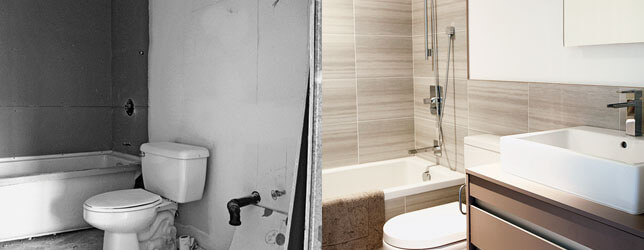Home renovation reality check
Home makeover shows give you the impression you can transform your house in a few short weeks. MoneySense shows you why real renovations are nothing like what you see on TV—and what you really need to know to pull off a successful remodeling.

 Home renovation shows tend to follow a set formula. The real-life couple is overwhelmed by a problem in their home—say a lime green 1970s kitchen or a water-damaged basement. The heroic host arrives on the scene, and with some tough love and a small army of contractors, transforms the home beyond recognition in almost no time, despite running into some unforeseen problems. The finished project is revealed to the couple, who are overwhelmed with joy when they see their gorgeous new home.
We all know what we see on television isn’t real, but just the same, a steady diet of home renovation shows over the last decade or so has changed our expectations. We are more educated about design, and increasingly we want the beautiful granite countertops and sleek open interiors we see on TV. But over the years, many homeowners have also picked up misconceptions about the renovation process. If you want to avoid frustrations and disappointment while doing your own home improvements, make sure you know how the TV shows differ from real life.
The costs on TV aren’t realistic. On a typical show, you might see a complete renovation of the main floor of a house for $35,000 or a high-end kitchen installed for $20,000. But are those figures realistic? “We don’t know what’s really factored into those numbers,” says interior designer Jutta van der Kuijp. “Is all the labour in there? Are the design fees in there? Are all the materials at cost?”
Robert Koci, associate publisher of Canadian Contractor magazine, is skeptical that the budgets you see on TV could be replicated in real life. “The show I tend to get caught up in most often is Love It Or List It. When I see their budgets sometimes I’m scratching my head. It seems like it costs half of what it normally would.” Koci says viewers should be aware that TV show costs could be lower because they might get donated materials and labour from contractors. “These shows are on really tight budgets,” he says. “The likelihood is they’re bringing in tilers and drywallers who are doing the work for the exposure.” (For a real breakdown of a TV budget, see “Warning: May Not Be Exactly as Shown.”)
In order to make a realistic budget for your own project, do research before you commit to a number. “Don’t set limits in your head if you’re not informed,” advises Tyrone Stanley, a carpenter and general contractor in Toronto. He says people tend to get anchored on a specific cost before they really understand the scope of the work. “They might think a kitchen renovation is going to cost $7,000, because they saw it on a TV show. Then later they realize that for it to be done correctly, it costs more, but they don’t want to do it right because they’re set on that $7,000.”
Renée Verret, a Toronto financial planner, advises her clients to start off by window shopping for materials so they know what they cost before they commit to a project. Then, she suggests, you should bring in a few contractors to get labour estimates. “We usually recommend people apply a 20% to 40% top-up on the labour quote because you never know what you’re going to run into in a reno,” Verret says. When you go out to buy the materials, make sure you bring your budget with you so you’ll stay on track.
Home renovation shows tend to follow a set formula. The real-life couple is overwhelmed by a problem in their home—say a lime green 1970s kitchen or a water-damaged basement. The heroic host arrives on the scene, and with some tough love and a small army of contractors, transforms the home beyond recognition in almost no time, despite running into some unforeseen problems. The finished project is revealed to the couple, who are overwhelmed with joy when they see their gorgeous new home.
We all know what we see on television isn’t real, but just the same, a steady diet of home renovation shows over the last decade or so has changed our expectations. We are more educated about design, and increasingly we want the beautiful granite countertops and sleek open interiors we see on TV. But over the years, many homeowners have also picked up misconceptions about the renovation process. If you want to avoid frustrations and disappointment while doing your own home improvements, make sure you know how the TV shows differ from real life.
The costs on TV aren’t realistic. On a typical show, you might see a complete renovation of the main floor of a house for $35,000 or a high-end kitchen installed for $20,000. But are those figures realistic? “We don’t know what’s really factored into those numbers,” says interior designer Jutta van der Kuijp. “Is all the labour in there? Are the design fees in there? Are all the materials at cost?”
Robert Koci, associate publisher of Canadian Contractor magazine, is skeptical that the budgets you see on TV could be replicated in real life. “The show I tend to get caught up in most often is Love It Or List It. When I see their budgets sometimes I’m scratching my head. It seems like it costs half of what it normally would.” Koci says viewers should be aware that TV show costs could be lower because they might get donated materials and labour from contractors. “These shows are on really tight budgets,” he says. “The likelihood is they’re bringing in tilers and drywallers who are doing the work for the exposure.” (For a real breakdown of a TV budget, see “Warning: May Not Be Exactly as Shown.”)
In order to make a realistic budget for your own project, do research before you commit to a number. “Don’t set limits in your head if you’re not informed,” advises Tyrone Stanley, a carpenter and general contractor in Toronto. He says people tend to get anchored on a specific cost before they really understand the scope of the work. “They might think a kitchen renovation is going to cost $7,000, because they saw it on a TV show. Then later they realize that for it to be done correctly, it costs more, but they don’t want to do it right because they’re set on that $7,000.”
Renée Verret, a Toronto financial planner, advises her clients to start off by window shopping for materials so they know what they cost before they commit to a project. Then, she suggests, you should bring in a few contractors to get labour estimates. “We usually recommend people apply a 20% to 40% top-up on the labour quote because you never know what you’re going to run into in a reno,” Verret says. When you go out to buy the materials, make sure you bring your budget with you so you’ll stay on track.
 Renovations take a long time. On TV, renovations go from conception to perfection in a few short weeks. But there are things the camera doesn’t show. “The stuff you see on TV always looks way better than the results you see on the ground,” says Koci, who once witnessed almost the entire renovation for a major Canadian show. “They did the big reveal at the end and the customer acted like, oh wow, they’ve never seen anything so beautiful. But at least 20% of the work hadn’t even been finished.”
Many renovation professionals complain that TV’s shortened timelines set up heightened expectations. “Some shows manage to have a renovation done in three days. There’s no way! Those would have been prepared for months in advance,” says van der Kuijp. “People are surprised when I tell them it will be eight weeks before their kitchen cabinets are built. The reality is it doesn’t happen faster than that, but the whole HGTV phenomenon has made it seem like they can build your whole kitchen in your driveway in a weekend and you’ll be entertaining on Monday. It’s unreasonable and it makes it very hard for us to do our jobs.”
Before you get started on your own renovations, draw up a timeline with the contractor so you’ll know what to expect. This will give you a baseline for discussion if things take longer than expected. If you need permits, be sure to build in extra time to get them from city hall.
It’s important to realize quality contractors aren’t necessarily available right away. “People just assume we’re sitting by the phone waiting for their phone call and that we can start tomorrow,” says Jason Heisler, a general contractor and carpenter in Sylvan Lake, Alta. “We generally book two to three months out or longer, depending on the job.” And no, even though the television programs show five or six trades working side by side, in reality you’ll usually want to schedule things so only one contractor (or two at the most) is in your home at once.
To keep things running smoothly, buy all your materials ahead of time, and remember it’s common for items to be out of stock or for the wrong product to be shipped. Give your contractor a green light to buy other materials as the need arises—even if he marks up the cost by a few bucks, it’s usually worth it to keep the process running smoothly if you aren’t around to react quickly.
People often feel under pressure to get their renovations over so they can be done with the stress and enjoy their improved surroundings, but you put yourself at increased risk of problems if you move too quickly. “You don’t have to do everything at once,” says Alan Elliot, a 41-year-old sound engineer who did extensive renovations on his home, a former restaurant in Willow Beach, Ont. “I understand no one wants to live through constant renovations, but if you plan it out slowly and wait to do some projects a couple years later, it’s a lot easier.”
DIY isn’t as easy as it looks. Watching the brawny contractors on TV might inspire you to break out your own toolkit. Sometimes the hosts even get hapless husbands to do some drywall or drilling, but sadly, nothing is as easy as it looks on TV. Koci says you need to make an honest assessment of what you can do yourself. “If you have all the time in the world, it’s quite realistic to do your own renovations, but often we don’t have the time to learn things properly,” he says. “If homeowners don’t have the patience or time, they won’t do it as well as a professional.”
If you decide to do some work on your own, make sure to get help from a buddy with some experience. “It’s not realistic for someone to read a book and then do their own renos properly, but it is realistic if they are being supervised by someone who knows what they’re doing,” says Stanley. Even so, you’re probably better off leaving plumbing, electrical and structural work to the pros.
You might regret borrowing to renovate. Ever see a reality TV program that shows an in-depth analysis of whether borrowing to renovate really fits into the homeowner’s overall financial plan? Me neither. But homeowners who don’t look at the big picture may live to regret it.
Before you commit to a project, get a financial planner to look at your situation, or use the MoneySense Complete Financial Plan Toolkit at www.moneysense.ca/plan. “You have to take an honest look at where you stand,” says Verret. “Obviously an improvement always sounds better, but your house doesn’t have to look like the house from the hospital fundraising lottery that costs $3.5 million.”
The danger with a line of credit is it doesn’t require you to repay principal and interest each month. “The lender often only requires interest and people fall under the assumption that they can manage the interest, therefore they can go ahead with the reno. That’s not the case at all, because eventually the principal has to be repaid,” says Verret.
She advises clients planning major renovations to save a sizable chunk of the money in advance. A high-interest savings account inside a TFSA can be a good place to stash your cash. “We are used to instant gratification in our society, so some people look at me in horror when I say, ‘Let’s save for that.’ They say it will take a long time and I say, ‘Yes it will. Then you’ll feel what it’s like to be without this money and that will prepare you to pay off the rest of the loan.’”
A line of credit secured against your home will give you a lower interest rate, but unless your lenders cover costs for legal fees and an appraisal, you may need to pay $700 to $1,100 to set one up. Most mortgages will allow you to take a home equity line of credit from another lender, so shop around for the best rate. According to mortgage broker Kim Gibbons, expect to pay 3.5% or more, depending on your credit history.
If you get a line of credit, make sure you have the cash flow to make the payments and cover your other financial obligations, and give yourself a deadline to pay it off. Lenders will usually extend credit if your monthly obligations are less than 40% of your gross income, says mortgage broker Robert McLister, but you’ll want to stay below that number to protect yourself against rising interest rates.
If you can’t pay off the debt promptly, you might be better off refinancing your mortgage. “You’re often wiser to get a one-to five-year locked-in mortgage below 3%,” says McLister. “That way you can save interest up front, shield yourself from some variable-rate risk, and pay off lump sums whenever you want, subject to your lender’s prepayment privileges.” If you currently have a fixed-rate mortgage, find out if you would need to pay penalties for breaking it early.
The reno may not add to your home’s resale value. On a recent episode of Income Property, host Scott McGillivray tells beaming homeowners Jerry and Amee that after putting $55,000 of work into their basement suite, the home that they bought just weeks before just increased in value by $84,000. (Costs on this reno are broken out in “Warning: May Not Be Exactly as Shown”) Homeowners like to justify pricey projects by tossing around numbers like this, but you need to be careful. The truth is, for a kitchen or bathroom reno, you can expect to recoup about two-thirds of your cost. (For more payback estimates, see “Is Your Reno Really an Investment?”)
Renovations take a long time. On TV, renovations go from conception to perfection in a few short weeks. But there are things the camera doesn’t show. “The stuff you see on TV always looks way better than the results you see on the ground,” says Koci, who once witnessed almost the entire renovation for a major Canadian show. “They did the big reveal at the end and the customer acted like, oh wow, they’ve never seen anything so beautiful. But at least 20% of the work hadn’t even been finished.”
Many renovation professionals complain that TV’s shortened timelines set up heightened expectations. “Some shows manage to have a renovation done in three days. There’s no way! Those would have been prepared for months in advance,” says van der Kuijp. “People are surprised when I tell them it will be eight weeks before their kitchen cabinets are built. The reality is it doesn’t happen faster than that, but the whole HGTV phenomenon has made it seem like they can build your whole kitchen in your driveway in a weekend and you’ll be entertaining on Monday. It’s unreasonable and it makes it very hard for us to do our jobs.”
Before you get started on your own renovations, draw up a timeline with the contractor so you’ll know what to expect. This will give you a baseline for discussion if things take longer than expected. If you need permits, be sure to build in extra time to get them from city hall.
It’s important to realize quality contractors aren’t necessarily available right away. “People just assume we’re sitting by the phone waiting for their phone call and that we can start tomorrow,” says Jason Heisler, a general contractor and carpenter in Sylvan Lake, Alta. “We generally book two to three months out or longer, depending on the job.” And no, even though the television programs show five or six trades working side by side, in reality you’ll usually want to schedule things so only one contractor (or two at the most) is in your home at once.
To keep things running smoothly, buy all your materials ahead of time, and remember it’s common for items to be out of stock or for the wrong product to be shipped. Give your contractor a green light to buy other materials as the need arises—even if he marks up the cost by a few bucks, it’s usually worth it to keep the process running smoothly if you aren’t around to react quickly.
People often feel under pressure to get their renovations over so they can be done with the stress and enjoy their improved surroundings, but you put yourself at increased risk of problems if you move too quickly. “You don’t have to do everything at once,” says Alan Elliot, a 41-year-old sound engineer who did extensive renovations on his home, a former restaurant in Willow Beach, Ont. “I understand no one wants to live through constant renovations, but if you plan it out slowly and wait to do some projects a couple years later, it’s a lot easier.”
DIY isn’t as easy as it looks. Watching the brawny contractors on TV might inspire you to break out your own toolkit. Sometimes the hosts even get hapless husbands to do some drywall or drilling, but sadly, nothing is as easy as it looks on TV. Koci says you need to make an honest assessment of what you can do yourself. “If you have all the time in the world, it’s quite realistic to do your own renovations, but often we don’t have the time to learn things properly,” he says. “If homeowners don’t have the patience or time, they won’t do it as well as a professional.”
If you decide to do some work on your own, make sure to get help from a buddy with some experience. “It’s not realistic for someone to read a book and then do their own renos properly, but it is realistic if they are being supervised by someone who knows what they’re doing,” says Stanley. Even so, you’re probably better off leaving plumbing, electrical and structural work to the pros.
You might regret borrowing to renovate. Ever see a reality TV program that shows an in-depth analysis of whether borrowing to renovate really fits into the homeowner’s overall financial plan? Me neither. But homeowners who don’t look at the big picture may live to regret it.
Before you commit to a project, get a financial planner to look at your situation, or use the MoneySense Complete Financial Plan Toolkit at www.moneysense.ca/plan. “You have to take an honest look at where you stand,” says Verret. “Obviously an improvement always sounds better, but your house doesn’t have to look like the house from the hospital fundraising lottery that costs $3.5 million.”
The danger with a line of credit is it doesn’t require you to repay principal and interest each month. “The lender often only requires interest and people fall under the assumption that they can manage the interest, therefore they can go ahead with the reno. That’s not the case at all, because eventually the principal has to be repaid,” says Verret.
She advises clients planning major renovations to save a sizable chunk of the money in advance. A high-interest savings account inside a TFSA can be a good place to stash your cash. “We are used to instant gratification in our society, so some people look at me in horror when I say, ‘Let’s save for that.’ They say it will take a long time and I say, ‘Yes it will. Then you’ll feel what it’s like to be without this money and that will prepare you to pay off the rest of the loan.’”
A line of credit secured against your home will give you a lower interest rate, but unless your lenders cover costs for legal fees and an appraisal, you may need to pay $700 to $1,100 to set one up. Most mortgages will allow you to take a home equity line of credit from another lender, so shop around for the best rate. According to mortgage broker Kim Gibbons, expect to pay 3.5% or more, depending on your credit history.
If you get a line of credit, make sure you have the cash flow to make the payments and cover your other financial obligations, and give yourself a deadline to pay it off. Lenders will usually extend credit if your monthly obligations are less than 40% of your gross income, says mortgage broker Robert McLister, but you’ll want to stay below that number to protect yourself against rising interest rates.
If you can’t pay off the debt promptly, you might be better off refinancing your mortgage. “You’re often wiser to get a one-to five-year locked-in mortgage below 3%,” says McLister. “That way you can save interest up front, shield yourself from some variable-rate risk, and pay off lump sums whenever you want, subject to your lender’s prepayment privileges.” If you currently have a fixed-rate mortgage, find out if you would need to pay penalties for breaking it early.
The reno may not add to your home’s resale value. On a recent episode of Income Property, host Scott McGillivray tells beaming homeowners Jerry and Amee that after putting $55,000 of work into their basement suite, the home that they bought just weeks before just increased in value by $84,000. (Costs on this reno are broken out in “Warning: May Not Be Exactly as Shown”) Homeowners like to justify pricey projects by tossing around numbers like this, but you need to be careful. The truth is, for a kitchen or bathroom reno, you can expect to recoup about two-thirds of your cost. (For more payback estimates, see “Is Your Reno Really an Investment?”)
 And if you choose the wrong renovation project or make unpopular design choices, you may get no return on your investment, or even reduce the value of your home. “A $12,000-porcelain sink for your bathroom will be beautiful in that high-end Rosedale home, but it’s a really stupid thing to put into a one-bedroom condo because it won’t be appreciated,” says Vancouver-area realtor Sarah Daniels. “By the same token, if you put a $20,000 kitchen in $2.5-million home, you might as well just burn the money. If it’s not up to the quality expected in the neighbourhood, don’t do it.” Also remember your new kitchen won’t be considered new unless you sell in the next couple years, meaning it may have no impact on the amount buyers are willing to pay.
If you’re concerned about resale value, shy away from ornate designs, bright colours and overly personalized renovation projects. “Pick something relatively neutral for your countertops and cabinetry, and then use bright colours and accents in paint,” says Daniels. “If you like bold colour choices, you can change the paint before you sell.”
You can’t afford to be passive. Our heroic TV hosts tend to dominate the renovation process, giving the owner only one or two chances to have input. Hosts are given free rein and often the homeowner doesn’t weigh in again until the project is finished. But in reality, if you take a passive role in your renovations, you’re likely to run into problems.
“The number-one reason why renovations fail is because homeowners took their eye off the ball,” says Koci. “Some homeowners believe what they’re paying for is the ability to abdicate responsibility. They think when you go with a high-priced contractor you should be able to disengage from the process. But when the customer disengages, it allows them to say it’s the contractor’s fault whenever something goes wrong, and things can spiral out of control.”
You certainly don’t want to micromanage your contractor’s every move, but you do need to stay on top of developments and be responsive when they ask you to make decisions. “Look at the details and listen to your intuition as to whether you like what you’re seeing,” says Koci.
Properly planned renovations are boring. TV renos are rife with dramatic moments where the contractors suddenly encounter surprises—for example, panic ensues after a wall is removed, revealing that a crucial support beam has been damaged. But while many renovations do encounter unexpected snags, a properly planned project won’t create major drama. “We try to make our renovations boring. There’s no excitement because everything’s well planned,” says Heisler. “If we’re tearing down a wall we give a heads-up to the homeowner that we don’t know what’s buried behind it. It seems like on the TV shows they purposely don’t do that to create that little bit of extra stress.”
Putting in the time to find the right contractor will reduce surprises. “People get very scared because all they hear is that renovations are a horror show, but it doesn’t have to be that way,” says Heisler. “Homeowners have to take some responsibility for the contractor they choose and for doing their homework. If the price sounds too good to be true, it probably is.” Never give the contractor all the money upfront—stay in control by paying in installments.
According to the CMHC, it’s common to pay a deposit of 5% to 15% when you sign a contract—more if you’re getting custom-made products, such as windows and doors. Another staple television plotline involves bickering between couples: for example, Jenny’s top priority is a slick modern kitchen with stainless steel appliances, while her husband Jim prefers to spend their money beefing up his sprawling entertainment room. This drama can be reduced by having frank conversations with your partner about your goals and expectations before you get started. “A lot of couples
assume they have the same vision for a project,” says Verret. “You need to have some really candid discussions about who’s responsible for what and make sure both partners are on board.”
A properly planned renovation may lack the drama of the TV version, but it’s deeply satisfying just the same. “Honestly, you feel like a million bucks when you have it all done and you can really see the results of all your efforts,” says Alan Elliot, who recently completed three years of off-and-on renovation projects, resulting in a new kitchen, bathroom and a complete suite for his mother-in-law. “You feel like it’s your home and your personality is in there, and that makes it a nice feeling when you come home.”
And if you choose the wrong renovation project or make unpopular design choices, you may get no return on your investment, or even reduce the value of your home. “A $12,000-porcelain sink for your bathroom will be beautiful in that high-end Rosedale home, but it’s a really stupid thing to put into a one-bedroom condo because it won’t be appreciated,” says Vancouver-area realtor Sarah Daniels. “By the same token, if you put a $20,000 kitchen in $2.5-million home, you might as well just burn the money. If it’s not up to the quality expected in the neighbourhood, don’t do it.” Also remember your new kitchen won’t be considered new unless you sell in the next couple years, meaning it may have no impact on the amount buyers are willing to pay.
If you’re concerned about resale value, shy away from ornate designs, bright colours and overly personalized renovation projects. “Pick something relatively neutral for your countertops and cabinetry, and then use bright colours and accents in paint,” says Daniels. “If you like bold colour choices, you can change the paint before you sell.”
You can’t afford to be passive. Our heroic TV hosts tend to dominate the renovation process, giving the owner only one or two chances to have input. Hosts are given free rein and often the homeowner doesn’t weigh in again until the project is finished. But in reality, if you take a passive role in your renovations, you’re likely to run into problems.
“The number-one reason why renovations fail is because homeowners took their eye off the ball,” says Koci. “Some homeowners believe what they’re paying for is the ability to abdicate responsibility. They think when you go with a high-priced contractor you should be able to disengage from the process. But when the customer disengages, it allows them to say it’s the contractor’s fault whenever something goes wrong, and things can spiral out of control.”
You certainly don’t want to micromanage your contractor’s every move, but you do need to stay on top of developments and be responsive when they ask you to make decisions. “Look at the details and listen to your intuition as to whether you like what you’re seeing,” says Koci.
Properly planned renovations are boring. TV renos are rife with dramatic moments where the contractors suddenly encounter surprises—for example, panic ensues after a wall is removed, revealing that a crucial support beam has been damaged. But while many renovations do encounter unexpected snags, a properly planned project won’t create major drama. “We try to make our renovations boring. There’s no excitement because everything’s well planned,” says Heisler. “If we’re tearing down a wall we give a heads-up to the homeowner that we don’t know what’s buried behind it. It seems like on the TV shows they purposely don’t do that to create that little bit of extra stress.”
Putting in the time to find the right contractor will reduce surprises. “People get very scared because all they hear is that renovations are a horror show, but it doesn’t have to be that way,” says Heisler. “Homeowners have to take some responsibility for the contractor they choose and for doing their homework. If the price sounds too good to be true, it probably is.” Never give the contractor all the money upfront—stay in control by paying in installments.
According to the CMHC, it’s common to pay a deposit of 5% to 15% when you sign a contract—more if you’re getting custom-made products, such as windows and doors. Another staple television plotline involves bickering between couples: for example, Jenny’s top priority is a slick modern kitchen with stainless steel appliances, while her husband Jim prefers to spend their money beefing up his sprawling entertainment room. This drama can be reduced by having frank conversations with your partner about your goals and expectations before you get started. “A lot of couples
assume they have the same vision for a project,” says Verret. “You need to have some really candid discussions about who’s responsible for what and make sure both partners are on board.”
A properly planned renovation may lack the drama of the TV version, but it’s deeply satisfying just the same. “Honestly, you feel like a million bucks when you have it all done and you can really see the results of all your efforts,” says Alan Elliot, who recently completed three years of off-and-on renovation projects, resulting in a new kitchen, bathroom and a complete suite for his mother-in-law. “You feel like it’s your home and your personality is in there, and that makes it a nice feeling when you come home.”











